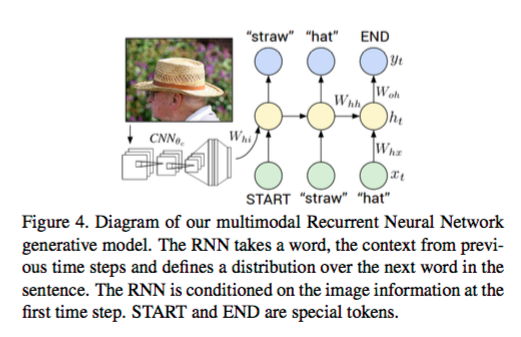Deep Visual-Semantic Alignments for Generating Image Description
1 Introduction
This paper uses CNN to learn image regions embedding, bidirectional RNN to learn sentence embeddings, associate them into a common multimodal space, and a structured objective to align two modalities. Then it proposes a mutlimodal RNN to learn to generate description of image regions using the aligned image-sentence pair.
2 Model Description
2.1 Learn to Align visual data and language data
First use RCNN to extract 19 regions from the image, use pre-trained CNN to express each regions with real-value vector.
 Wm: h*4096
Wm: h*4096
2.2 Represent Sentence
Use Bidirectional Recurrent Neural Network.

use word2vec to initilize the word vector and keep fixed during training.
2.3 Alignment objective
The objective encourages aligned image-sentence pairs to have a higher score than misaligned pairs by a margin.


gk is a set of image-regions, gl is a set of sentence fragments.
Then Skl measures how well sentence l and image k are aligned.
2.4 Decoding text segment alignments to images

 why not Vt*Sj?
why not Vt*Sj?
(N words. M image regions , aj [1...M ])
The aim is to align continuous text sequences of words to a single bounding box.
We minimize the energy to find the best alignments using dynamics. The output is a set of image regions annotated with segments of text.
2.5 Multimodal Recurrent Neural Network for generating descriptions


3 Limitation.
Model can only generate a description of one input array of pixels at a fixed resolution.
A more sensible approach might be to use their mutual interactions and wider context before generating a description.
And the approach consists of two seperate models. Going directly from an image-sentence dataset to region-level annotations as part of a single model trained end-to-end may be more desirable.